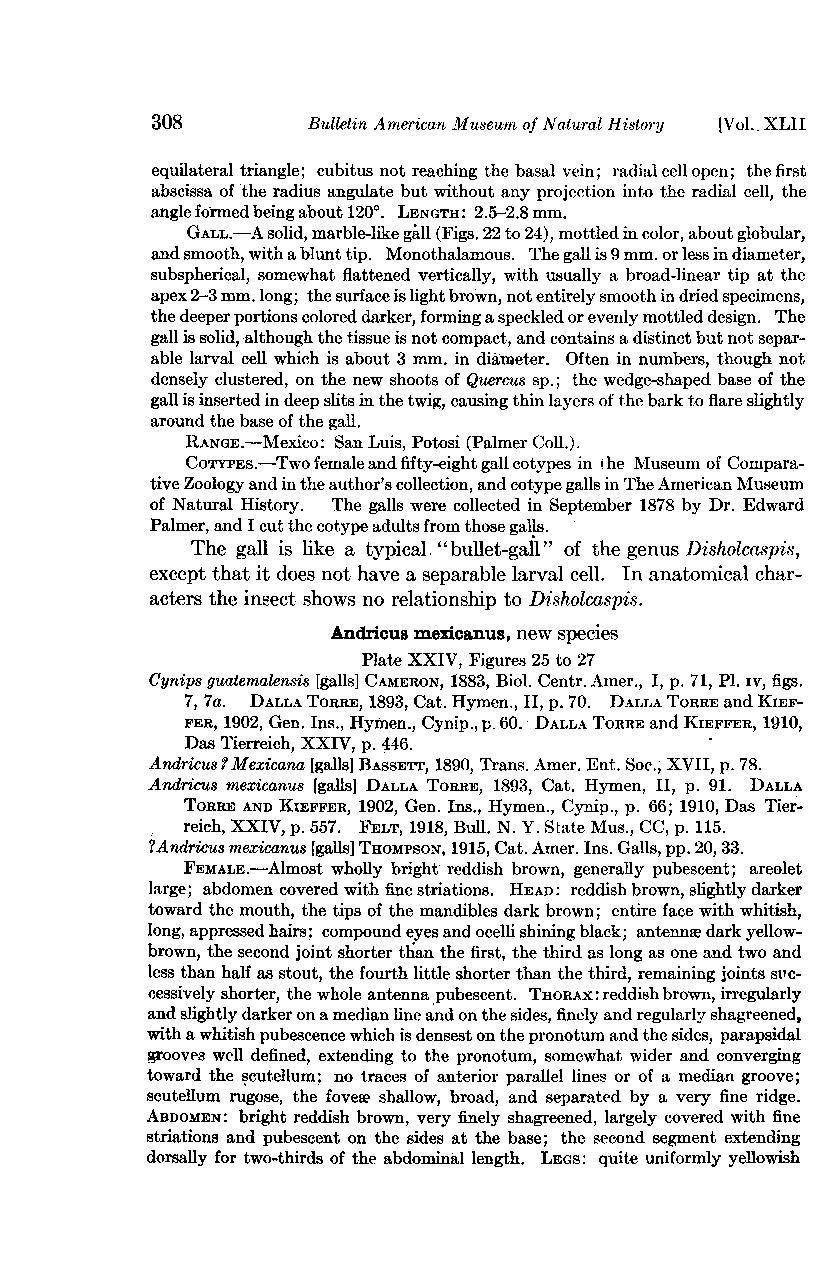equilateral triangle; cubitus not reaching the basal vein; radial cell open; the first abscissa of the radius angulate but without any projection into the radial cell, the angle formed being about 120°. Length: 2.5–2.8 mm.
Gall.—A solid, marble-like gall (Figs. 22 to 24), mottled in color, about globular, and smooth, witn a blunt tip. Monothalamous. The gall is 9 mm. or less in diameter, subspherical, somewhat flattened vertically, with usually a broad-linear tip at the apex 2–3 mm. long; the surface is light brown, not entirely smooth in dried specimens, the deeper portions colored darker, forming a speckled or evenly mottled design. The gall is solid, although the tissue is not compact, and contains a distinct but not separable larval cell which is about 3 mm. in diatmeter. Often in numbers, though not densely clustered, on the new shoots of Quercus sp.; the wedge-shaped base of the gall is inserted in deep slits in the twig, causing thin layers of the bark to flare slightly around the base of the gall.
Range.—Mexico: San Luis, Potosi (Palmer Coll.).
Cotypes.—Two female and fifty-eight gall cotypes in the Museum of Comparative Zoology and in the author's collection, and cotype galls in The American Museum of Natural History. The galls were collected in September 1878 by Dr. Edward Palmer, and I cut the cotype adults from those galls.The gall is like a typical “bullet-gall” of the genus Disholcaspis, except that it does not have a separable larval cell. In anatomical characters the insect shows no relationship to Disholcaspis.
Andricus mexicanus, new species
Plate XXIV, Figures 25 to 27
Andricus ? Mexicana [galls] Bassett, 1890, Trans. Amer. Ent. Soc., XVII, p. 78.
Andricus mexicanus [galls] Dalla Torre, 1893, Cat. Hymen, II, p. 91. Dalla Torre and Kieffer, 1902, Gen. Ins., Hymen., Cynip., p. 66; 1910, Das Tierreich, XXIV, p. 557. Felt, 1918, Bull. N. Y. State Mus., CC, p. 115.
?Andricus mexicanus [galls] Thompson, 1915, Cat. Amer. Ins. Galls, pp. 20, 33.
Female. Almost wholly bright reddish brown, generally pubescent; areolet large; abdomen covered with fine striations. Head: reddish brown, slightly darker toward the mouth, the tips of the mandibles dark brown; entire face with whitish, long, appressed hairs; compound eyes and ocelli shining black; antennæ dark yellow-brown, the second joint shorter than the first, the third as long as one and two and less than half as stout, the fourth little shorter than the third, remaining joints successively shorter, the whole antenna pubescent. Thorax: reddish brown, irregularly and slightly darker on a median line and on the sides, finely and regularly shagreened, with a whitish pubescence which is densest on the pronotum and the sides, parapsidal grooves well defined, extending to the pronotum, somewhat wider and converging toward the scutellum; no traces of anterior parallel lines or of a median groove; scutellum rugose, the foveæ shallow, broad, and separated by a very fine ridge. Abdomen: bright reddish brown, very finely shagreened, largely covered with fine striations and pubescent on the sides at the base; the second segment extending dorsally for two-thirds of the abdominal length. Legs: quite uniformly yellowish